Antifungal Treatment Selector
Get personalized recommendations for topical antifungals based on your infection type, skin sensitivity, and treatment preferences. Note: This tool is for informational purposes only and does not replace medical advice.
Step 1: Identify Your Infection
Select the type of fungal infection you're treating
Step 2: Skin Sensitivity
How sensitive is your skin to topical treatments?
Step 3: Treatment Preferences
What matters most to you?
Recommendations
Important note: This tool is based on information from the article comparing various topical antifungals. Always consult with a healthcare provider for a proper diagnosis and treatment plan.
If you’ve ever struggled with itchy, scaly athlete’s foot, you’ve probably heard of Lamisil Cream. Lamisil Cream is a topical antifungal containing the active ingredient Terbinafine, which works by disrupting fungal cell membranes and stopping growth. But the market is crowded - clotrimazole, miconazole, ketoconazole, naftifine and even ciclopirox nail lacquer all claim to be the "best" option. This guide compares Lamisil Cream with those alternatives, so you can pick the product that matches your infection type, skin sensitivity and lifestyle.
How Lamisil Cream Works
Terbinafine is a synthetic allylamine that targets the fungal enzyme squalene epoxidase. By blocking this step, the drug causes a toxic buildup of squalene inside the fungus, leading to cell death. Because it attacks a different pathway than many azole antifungals, resistance is less common.
The cream is usually applied twice daily for one to two weeks, depending on the infection site. Clinical trials in Australia and the United States report cure rates of 80‑90% for athlete’s foot (tinea pedis) and 70‑85% for jock itch (tinea cruris).
Common Alternatives and Their Basics
- Clotrimazole Cream - an imidazole antifungal that interferes with ergosterol synthesis. It’s been on the market since the 1970s and is often the first‑line OTC choice for mild infections.
- Miconazole Cream - another imidazole with a broader spectrum, covering dermatophytes, yeasts and some moulds. Typically used twice daily for 2‑4 weeks.
- Ketoconazole Cream - a potent azole that penetrates thick skin. Prescription‑only in many countries for chronic or resistant cases.
- Naftifine Cream - an allylamine like terbinafine but with a slightly different binding profile. Approved for tinea corporis and tinea pedis, usually applied once daily.
- Ciclopirox Nail Lacquer - a hydroxypyridone formulation designed for on‑ychomycosis (fungal nail infection). Requires weekly application for up to 48 weeks.
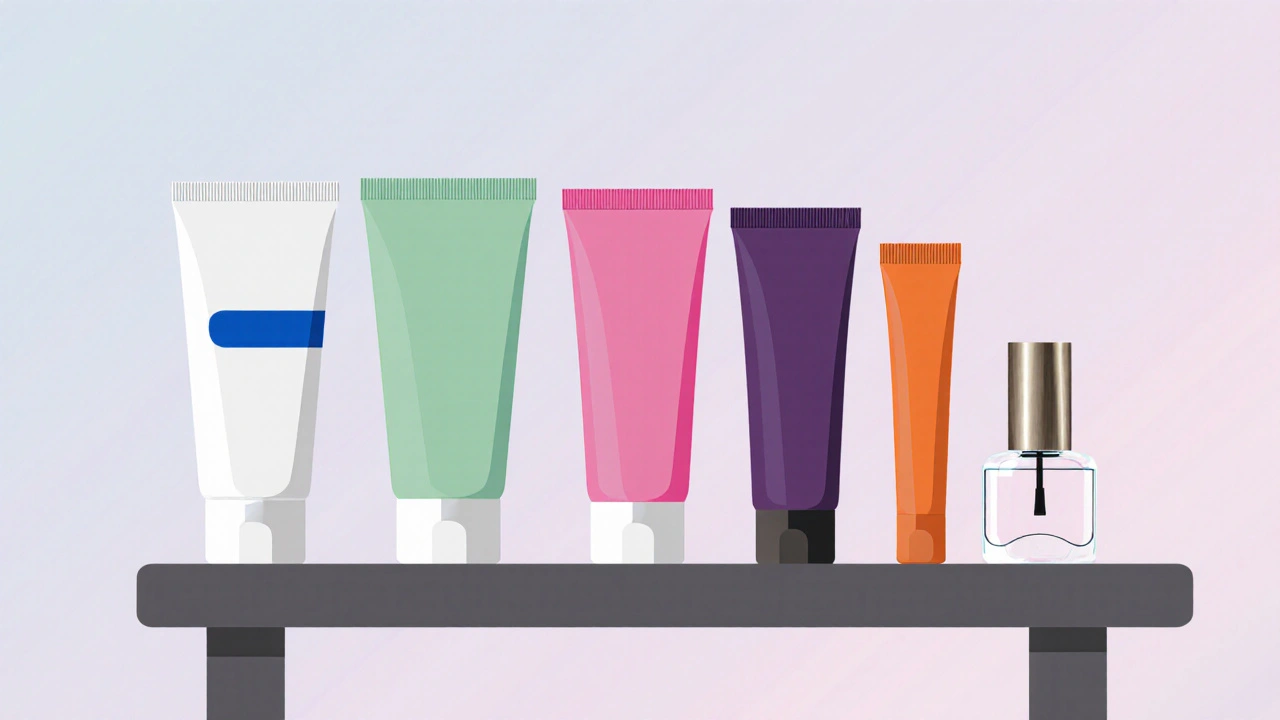
Side‑by‑Side Comparison
| Product | Active Ingredient | Typical Indications | Standard Duration | Common Side Effects | Approx. Success Rate* |
|---|---|---|---|---|---|
| Lamisil Cream | Terbinafine | tinea pedis, tinea cruris, tinea corporis | 1-2 weeks | mild burning, itching | 80-90% |
| Clotrimazole Cream | Clotrimazole | tinea pedis, tinea corporis, candidiasis | 2-4 weeks | dryness, mild irritation | 65-75% |
| Miconazole Cream | Miconazole nitrate | tinea pedis, tinea cruris, candida | 2-4 weeks | burning, redness | 70-80% |
| Ketoconazole Cream | Ketoconazole | tinea corporis, seborrheic dermatitis | 2-6 weeks | itching, contact dermatitis | 75-85% |
| Naftifine Cream | d>Naftifine hydrochloridetinea pedis, tinea corporis | 1-2 weeks | dryness, occasional rash | 78-88% | |
| Ciclopirox Nail Lacquer | Ciclopirox olamine | onychomycosis (nail fungus) | up to 48 weeks | temporary discoloration, mild irritation | 55-65% |
*Success rates are based on peer‑reviewed clinical studies published between 2019 and 2023 and may vary with patient compliance.
How to Choose the Right Product
- Identify the infection. Athlete’s foot (tinea pedis) and jock itch (tinea cruris) respond well to allylamines like Lamisil or Naftifine. If you have a yeast‑driven infection (Candida), an imidazole such as clotrimazole or miconazole may be more appropriate.
- Consider treatment length. Shorter courses (1‑2 weeks) improve adherence. Lamisil and Naftifine are the only OTC creams that reliably clear infection within that window.
- Check for skin sensitivity. People with sensitive skin often report less irritation with terbinafine compared to azoles, which can feel more burning.
- Look at availability. Lamisil Cream is sold over‑the‑counter in most Australian pharmacies. Ketoconazole, however, requires a prescription in many states.
- Cost matters. Generic terbinafine cream typically costs $10‑$15 for a 15g tube, while brand‑name clotrimazole can be slightly cheaper per gram. Ciclopirox nail lacquer is the most expensive option due to the long treatment period.
By weighing these factors, most users find Lamisil Cream a solid first‑line choice for classic dermatophyte infections.
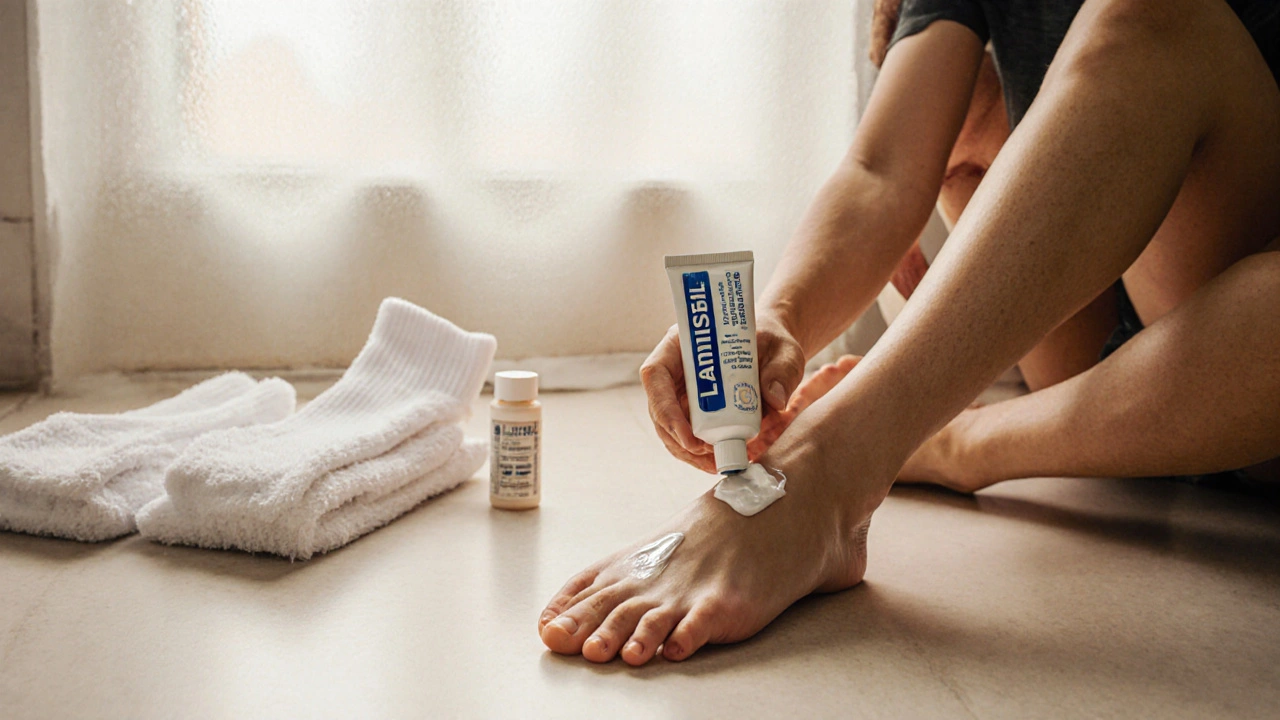
Practical Tips for Using Topical Antifungals
- Wash the affected area with soap and water, then dry thoroughly - fungi thrive in moisture.
- Apply a thin layer, rubbing it in until the skin looks slightly shiny. Over‑application doesn’t speed healing.
- Continue the full course even if symptoms disappear; stopping early leads to recurrence.
- Avoid occlusive dressings unless directed by a doctor - they trap heat and may worsen the infection.
- Change socks and underwear daily and consider an antifungal powder for the feet if you sweat heavily.
When to Seek Medical Advice
If you notice any of the following, stop self‑treating and book an appointment:
- Spreading redness or swelling beyond the original patch.
- Severe pain, blistering, or pus - signs of secondary bacterial infection.
- Persistent infection after 4weeks of consistent cream use.
- Fungal infection of the nails that hasn’t improved after 2‑3months of topical therapy.
- Allergic reaction: intense itching, rash, or swelling at the application site.
In such cases, a doctor may prescribe oral terbinafine tablets, a stronger azole, or refer you to a dermatologist for laser or surgical options.
Frequently Asked Questions
Can I use Lamisil Cream for nail fungus?
Lamisil Cream is formulated for skin infections. For onychomycosis, the oral tablet (250mg daily for 6 weeks) or the ciclopirox nail lacquer is usually recommended. Topical cream rarely penetrates the nail plate enough to cure the infection.
Is it safe to use Lamisil Cream on children?
In Australia, Lamisil Cream is approved for children aged 2years and older, provided the dosage is reduced to a thin layer once daily after the first 2days. Always check the packaging and consult a pharmacist if unsure.
How does terbinafine differ from azole antifungals?
Terbinafine (an allylamine) blocks squalene epoxidase, causing toxic squalene buildup. Azoles block ergosterol synthesis later in the pathway. Because they act on different enzymes, terbinafine often works faster and has lower resistance rates for dermatophytes.
Can I combine Lamisil Cream with an oral antifungal?
Yes, doctors sometimes prescribe both to speed clearance of extensive infections. The combination does not usually increase side‑effects, but you should follow the prescriber’s guidance.
What should I do if I develop a rash after applying the cream?
Stop using the product immediately, rinse the area with cool water, and apply a gentle moisturizer. If the rash persists for more than 24hours or worsens, seek medical attention as it could be an allergic reaction.
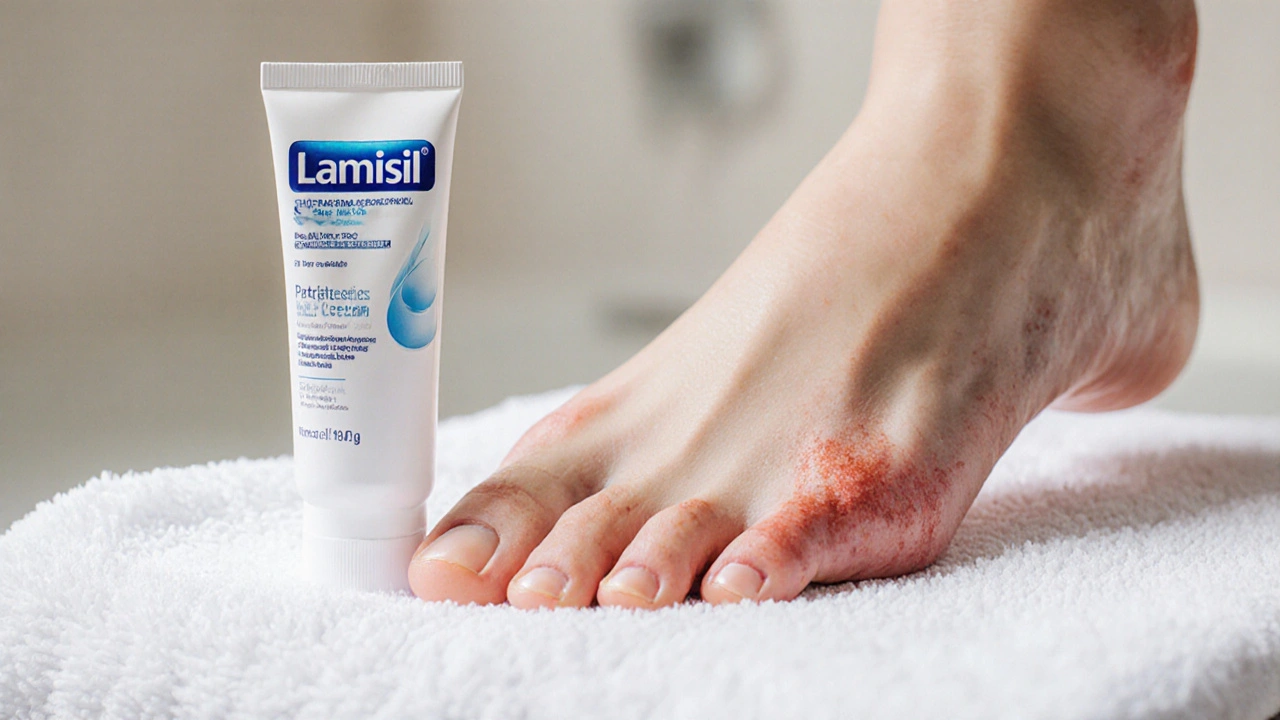


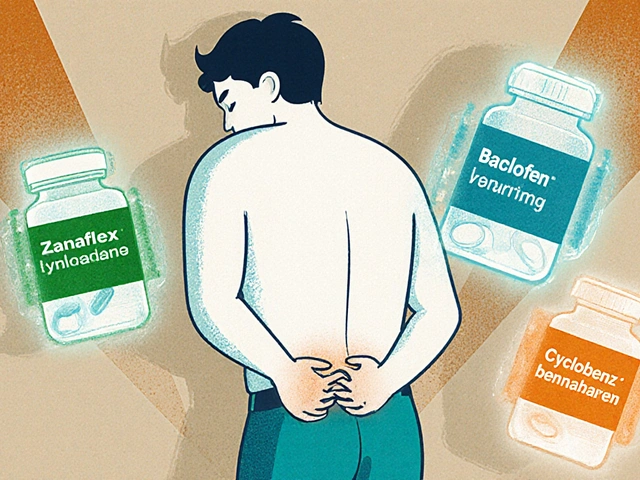
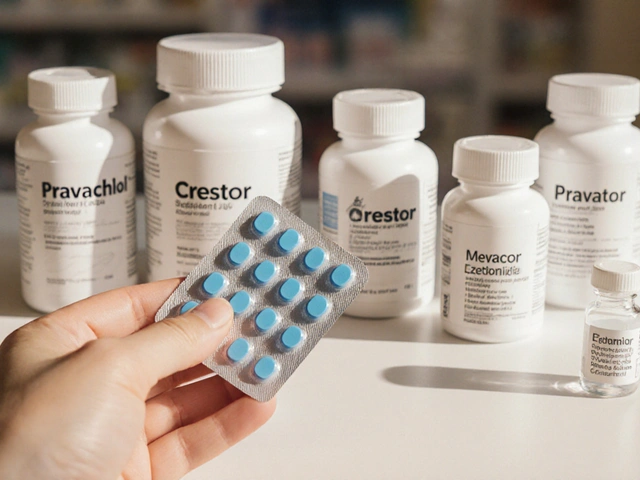

David McClone
October 13, 2025 AT 17:16Oh great, another miracle cream that promises a two‑week cure while you’re still wearing flip‑flops.
Jessica Romero
October 17, 2025 AT 04:36When you’re parsing the pharmacodynamics of topical antifungals, it’s crucial to differentiate between allylamine and azole mechanisms of action. Terbinafine, the active moiety in Lamisil, exerts its fungistatic effect by irreversible inhibition of squalene epoxidase, precipitating intracellular squalene accumulation. Conversely, clotrimazole and miconazole target the lanosterol 14α‑demethylase (CYP51), disrupting ergosterol biosynthesis at a downstream node. This enzymatic divergence translates clinically into disparate minimum inhibitory concentrations (MICs), which is why terbinafine consistently achieves 80‑90 % mycological cure rates in controlled trials. Naftifine, another allylamine, binds the same enzyme but with a slightly different affinity profile, allowing once‑daily dosing without compromising efficacy. Azoles such as ketoconazole possess a broader spectrum against dermatophytes and yeasts but are more susceptible to resistance via up‑regulation of efflux pumps. The pharmacokinetic ceiling of topical azoles is limited by their higher molecular weight, which can impede dermal penetration in hyperkeratotic zones. For tinea pedis, the stratum corneum’s lipid‑rich environment favors the lipophilic terbinafine, facilitating rapid diffusion to the fungal hyphae. In contrast, intertriginous areas like the groin exhibit higher humidity, which can enhance the efficacy of hydrophilic azoles but also increase the risk of maceration. From a safety standpoint, terbinafine’s adverse event profile is dominated by mild burning sensations, whereas azoles more frequently cause contact dermatitis due to their intrinsic irritancy. Cost analysis reveals that generic terbinafine and clotrimazole occupy a similar price bracket, but insurance formularies often prioritize the former for its shorter treatment duration. Clinical guidelines from the International Society for Antimicrobial Chemotherapy (ISAC) recommend allylamines as first‑line agents for uncomplicated dermatophyte infections. Patient adherence improves dramatically when the prescribed regimen does not exceed two weeks, underscoring the practical advantage of Lamisil’s rapid course. Nevertheless, for recalcitrant or extensive cases, combination therapy-topical allylamine plus oral azole-can be justified to achieve synergistic mycological clearance. Ultimately, the choice hinges on infection topography, patient skin sensitivity, and the prescriber’s comfort with the pharmacologic nuances of each compound.
Michele Radford
October 17, 2025 AT 04:53While your sarcasm may amuse the casual reader, the moral imperative remains: prescribing a potent antifungal without proper diagnosis borders on medical negligence. The market is saturated with over‑the‑counter options, yet many consumers treat symptoms as a DIY project, ignoring potential bacterial superinfection. It is ethically indefensible to champion any single product as universally superior without acknowledging individual contraindications. Patients deserve transparent risk‑benefit analysis, not marketing fluff.
Mangal DUTT Sharma
October 20, 2025 AT 16:30Hey folks 😊, I totally get how frustrating it can be when the itch just won’t quit, especially after a long day at work. 🌿 One thing that helped me was pairing Lamisil Cream with a good foot‑drying routine – apply the cream, let it absorb, then slip on cotton socks that breathe. 👣 I also keep a small packet of antifungal powder in my gym bag; a quick sprinkle after showering cuts down moisture, which is the fungal playground. Remember, consistency is key – even if the skin feels better after a few days, finish the full course to prevent relapse. If you have extra sensitive skin, a gentle moisturizer after the cream can soothe any lingering tingling. Stay strong, and may your skin find peace soon!
Gracee Taylor
October 24, 2025 AT 04:06Both Lamisil and its alternatives have their niches, so choosing one ultimately depends on your specific scenario. If you prioritize a short treatment window, the allylamine class, especially terbinafine, generally wins. However, for mild yeast infections, an imidazole like clotrimazole might be just as effective and often cheaper. It’s all about balancing efficacy, cost, and skin tolerance.
Leslie Woods
October 24, 2025 AT 04:23Lamisil works fast because it kills fungi by building up squalene its short course beats most azoles
Sunil Kamle
October 27, 2025 AT 15:51Esteemed members of this forum, allow me to extend my heartfelt commendation for anyone embarking upon the regimen of topical terbinafine; your commitment to evidence‑based therapy is admirable, albeit tinged with a faint flicker of irony given the plethora of OTC alternatives that masquerade as panaceas. Rest assured, perseverance shall reward you with clear, unblemished skin.
Michael Weber
October 31, 2025 AT 03:20In the grand theater of dermal health, the choice of antifungal becomes a reflection of our collective ethos: do we seek swift, decisive action, or do we linger in tentative compromise? Terbinafine embodies the former, a resolute protagonist against dermatophytes. Yet, let us not dismiss the nuanced roles of azoles, which, like seasoned philosophers, contemplate the broader fungal spectrum. Ultimately, the skin’s quiet gratitude speaks louder than any marketing slogan.
Blake Marshall
November 3, 2025 AT 14:48Lamisil is the best because i read it on the internet and my cousin swears by it it cured his foot fungus in like 5 days dont trust the doc you know
duncan hines
November 7, 2025 AT 02:16OH GREAT, another "miracle" cream that promises to vanquish fungus in days, as if my feet aren't already a battlefield of mold, bacteria, and existential dread! This so‑called solution is nothing more than a marketing gimmick, a cheap band‑aid for a problem that demands actual medical attention. Everyone knows that if a product works so quickly, it must be cutting corners or hiding side‑effects. Wake up, people, before you end up with a rash that looks like a lava field!
Mina Berens
November 10, 2025 AT 13:45Cool info, thanks for the deep dive 🙌. I’ll probably try the Lamisil thing if the itch sticks around.